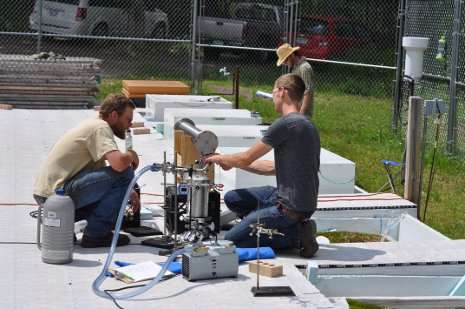New insight into carbon emissions from big carbon sinks in peat bogs

Flooding is the way of life in peat bogs. The standing water helps create an environment where mosses, sedges and shrubs flourish. As each year passes, a thick new layer of vegetation buries the old. Layer and layer of partially decomposed organic matter piles into peat, which slowly gathers and stores tons of carbon over centuries. With so much old plant material trapped in them, these flooded peat bogs affect much bigger carbon and climate systems.
Drought, however, may become more common for peat bogs. In the Great Lakes region, the effects of changing water conditions can be amplified by changing vegetation.
New research from Michigan Technological University teases out on how water levels, sedges and shrubs interact in changing peat bogs—and how they affect carbon emissions. The results were published in Plant Soil in January, featuring the Michigan Tech research as the issue's cover photo. The work is part of an ongoing study.
Carbon emissions in a mesocosm
In collaboration with the US Forest Service (USFS), researchers scrutinized these interactions using a mesocosm—a controlled experiment with meter-square boxes of peat bog that are like supersized garden pots. The mesocosm allows the researchers to regulate what goes in and out of the boxed peat bogs, a level of control impossible in nature.
Study co-author Evan Kane, an assistant professor in Michigan Tech's School of Forest Resources and Environmental Science, calls the bogs "nature's Swiss bank accounts" for carbon.
"Just like a bank account, peat carbon is regulated by inputs and outputs," he says, explaining that the mesocosm is convenient for study because it is an entire ecosystem in a container. From the highest stems to the deepest roots, a lot of variables can be monitored and manipulated.
Being able to control the amount of water going in enables Kane and his fellow researchers to mimic drought and flood conditions. Changing those water levels then affects what vegetation grows. By studying two plants in particular—sedges and shrubs—the team examined the effects of plant community changes on carbon emissions.
"It's not surprising that water table levels are a main driver," says Kane. "But we were surprised at the magnitude of the vegetation effects."
Specifically, when the controlled peat bogs were dried out, the sedges generated significant changes. Sedges are water-loving, triangular-bladed plants that resemble grass and have adapted well to marshy environments. They use "snorkel cells"—a special plant tissue called aerenchyma—to transport oxygen down to organisms in the soil that help the plants take up nutrients. More oxygen means more potential microbe activity—and an increase of greenhouse gases coming out.
Over time, dry bogs are more likely to favor shrubs, however. Shrubs are more effective at storing carbon, releasing less carbon dioxide and methane, and they don't use snorkel cells to bring oxygen down and extract nutrients from the peat. Based on this, extended drought could actually result in more carbon uptake in peat bog systems; this is a key question that the USFS collaborators are looking into.
"The vegetation matters," Kane says, "but the moss matters most."
Moss communities changed and shriveled in drier peat bogs, Sphagnum in particular in mesocosms where mostly sedges grew. Beyond the box and out in natural conditions, this would result in a bog subsiding or sinking down. The cause of subsidence—most likely microbes or structural changes—might impact carbon emissions, too.
Under the mesocosm
All that vegetation and carbon is hard to imagine unless you can stand under the mesocosms and actually see it.
Below ground, a long tunnel houses the bog bottoms, cased in corrugated metal boxes. They line the walls, attached to tubes, pipes and valves, and the room smells faintly earthy. Kane works with a USFS staff member to remove one of the box fronts, revealing baby blue insulation foam board, and behind that, a window deep under the soil.
Kept just above freezing, the soil of the peat bog is dark and very wet. Thin white lines, curling root filaments, reach out towards the glass. Even for researchers immersed in studying bogs and roots, this window gives a unique perspective.
"I teach a soils class," Kane says. "And in three minutes I can not only have students standing in a peat bog, but under it as well."
Kane places the insulated metal back over the glass, securing it with a bungee cord, and closes off the view into the mesocosm depths.
More information: "Effects of water table position and plant functional group on plant community, aboveground production, and peat properties in a peatland mesocosm experiment (PEATcosm)." Plant and Soil February 2015, Volume 387, Issue 1-2, pp 277-294 DOI: 10.1007/s11104-014-2301-8
Provided by Michigan Technological University


















